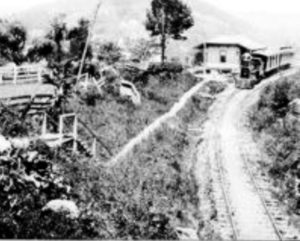NORFOLK’S RAILROADS: PAST AND PRESENT
Riding the Rails
By Joel Howard
Cool summers and soothing solitude captured the imagination of city dwellers, making Norfolk a holiday destination in the late 1800’s. A respite from everything loud, crowded, and dirty, Norfolk was quickly on the road to becoming a summer getaway, owing in no small part to the arrival of local rail service in 1871.
The most obvious remnant of Norfolk’s railroad past is seen in the form of the old
train station downtown. Now used for offices and Station Place Café, it stands much as it
did many decades ago. Less obvious are the old rail beds and trestles that stretch across Norfolk, wending their way from the south across Winchester Road and then traveling north along the west side of Route 272. After leaving the center of town, the rails head toward Canaan along a path north of Route 44.
Articles from long defunct newspapers tell of how Mr. Egbert Butler championed the fight for a railroad through Norfolk. Scoffed at, Butler soldiered on with his idea. As he said in an interview of the time, “I became impressed with the idea that a railroad through Norfolk was the only thing that could prevent its becoming practically an abandoned town.”
This was at a crucial time for the town, as an influx of summer residents soon augmented the local economy, giving life to declining commerce. One indicator of the vital role the rails played is seen in the fact that at one time four stations served Norfolk – Norfolk, Grants, Summit, and West Norfolk stations.

Heading east as it comes in from West Norfolk, a train (c. 1880) waits at the original downtown Norfolk station.
From that very first train clanking and hissing into Norfolk, summer continues to draw residents and visitors alike. For residents – whether permanent or part-time – the possibility exists to visit at least portions of the railroad that brought seekers of a peaceful haven to Norfolk almost 140 years ago.
Long stretches of the original rail bed are still out there, awaiting explorers who seek both tranquility and scenic views as they experience the outdoors. According to Norfolk Land Trust, which owns many of the rail beds, some sections are hit and miss in terms of having permission for passage via a right-of-way.
“It’s a long-standing dream of the Norfolk Land Trust to eventually link all the pieces of the rail bed together so that we can walk from one end of town to the other along a greenway,” commented Land Trust member Susannah Wood.
Two areas that provide long stretches of uninterrupted hiking are the Stoney Lonesome and Mad River sections. Those names alone recall days of yore and serve as inspiration for the adventurer of today.
Along Stoney Lonesome, one can see where an eastbound milk train derailed back in 1882. The pin used in righting the train is still visible for those with foreknowledge of the town’s rich railroad history. This section is true to its name, as the steep cliffs of rock on either side make for a feeling of solitude. Entering from Locust Hill Road two-tenths of a mile north of route 44, one can walk 1-1/2 miles and be rewarded with beautiful vistas.
Along Grantville Road, near Smith Pond, an entrance to the Mad River section of rail bed is posted with Norfolk Land Trust signs. Here one can enter a stretch of rail bed that falls just short of joining with route 272, all the while surrounded by trees that arch inward over the trail.
These paths allow for wonderful viewing of local plants and flowers during spring and summer, and would almost certainly be an ideal spot for seeing spectacular fall foliage. Even winter provides opportunities for excellent snow shoeing and cross country ski adventures.
Much as is seen today in the business world, the train system went through many incarnations as mergers and acquisitions occurred, always predicated on the financial needs of the various owners. History repeats itself in ways both surprising and predictable, allowing that Norfolk’s rail beds may one day again see service as the ebb and flow of transportation realities change with the capriciousness of power and politics.
Remember Mr. Butler, whose persistence in the face of great skepticism left a rich heritage, much of which can be enjoyed today with some nice weather and a good pair of hiking boots. And as the adage ‘what’s old is new again’ often proves, there remains the possibility – however remote – that trains may once again traverse Norfolk’s those empty rail beds.
